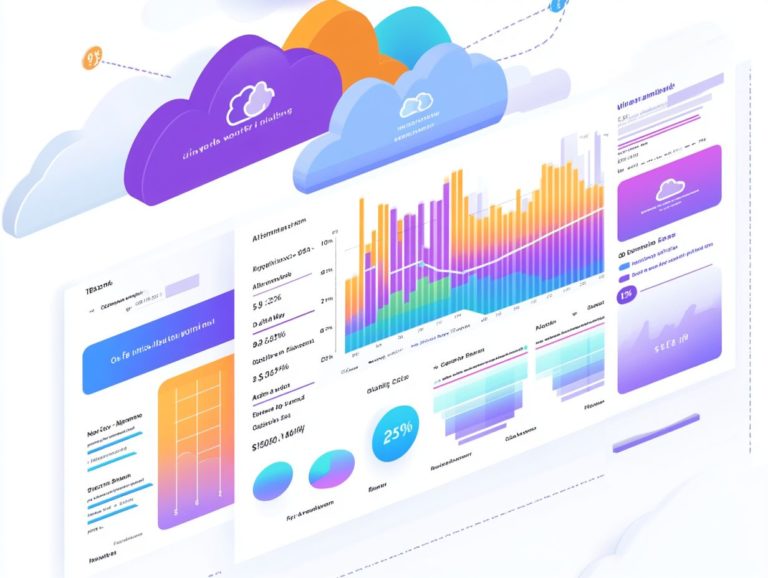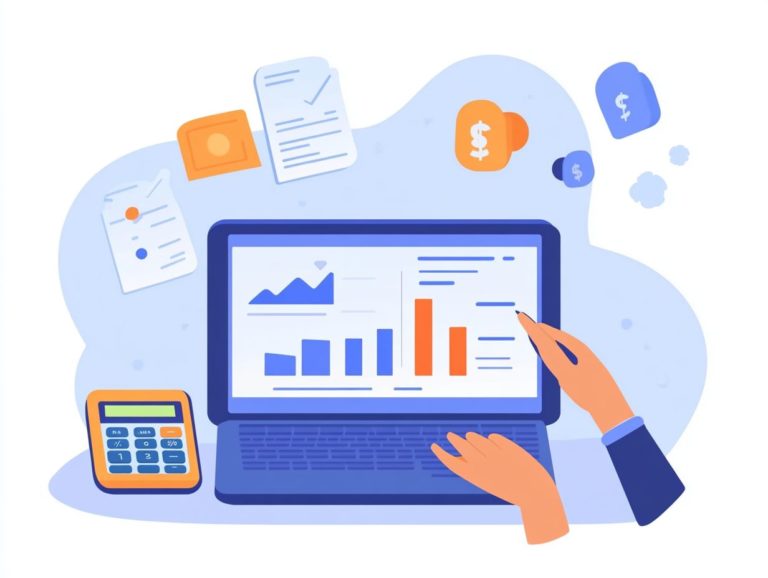5 Strategies for Reducing Cloud Costs
In today s digital landscape, cloud computing provides remarkable flexibility and scalability. Managing costs, however, can pose a significant challenge.
As you embark on your cloud journey, it s not uncommon to encounter soaring expenses. Fortunately, there are effective strategies to keep costs in check without compromising performance.
This article delves into five essential approaches, ranging from optimizing your cloud infrastructure to adopting a multi-cloud strategy. Explore these practical tips designed to help you maximize your cloud investment while minimizing waste.
Contents
- Key Takeaways:
- 1. Optimize Your Cloud Infrastructure
- 2. Use Reserved Instances
- 3. Utilize Auto-Scaling and Load Balancing
- 4. Monitor and Analyze Your Cloud Usage
- 5. Consider a Multi-Cloud Strategy
- What Are the Main Factors That Contribute to High Cloud Costs?
- What Are the Benefits of Using Reserved Instances?
- How Can Auto-Scaling and Load Balancing Help Reduce Costs?
- What Are the Best Tools for Monitoring and Analyzing Cloud Usage?
- What Are the Pros and Cons of a Multi-Cloud Strategy?
- Frequently Asked Questions
Key Takeaways:
Here’s what you need to remember:

Optimizing your cloud infrastructure is key to reducing costs and improving efficiency.
Using reserved instances can provide significant cost savings and flexibility for your cloud usage.
Implementing auto-scaling and load balancing allows you to manage resource usage efficiently, leading to cost savings.
1. Optimize Your Cloud Infrastructure
Start your optimization journey by ensuring your cloud resources are utilized effectively. This will maximize performance and flexibility.
Use proven methods to manage your cloud by tailoring strategies to meet your unique business needs and employing advanced solutions for seamless workload management.
To get started, assess your current cloud architecture. This step helps you pinpoint areas for improvement and identify potential bottlenecks.
Utilizing cloud monitoring tools provides real-time insights, enabling you to track performance metrics and resource utilization with precision.
Implementing financial controls is critical to ensuring your expenditures stay aligned with budgetary constraints and preventing unexpected overruns.
By leveraging cloud providers’ capabilities like automated migration services and advanced security features you can streamline migrations, enhance compliance measures, and ultimately cultivate a healthier, more agile cloud environment.
2. Use Reserved Instances
Utilizing reserved instances can lead to impressive cloud savings, offering lower pricing for committed cloud capacity over a specified term. This allows you to budget your cloud costs more effectively.
This strategic approach stands in stark contrast to on-demand pricing, which often fluctuates based on usage and can catch you off guard with unexpected expenses.
Opting for reserved instances can lead to substantial cost reductions sometimes exceeding 70% compared to standard on-demand rates. This model shines particularly bright during periods of predictable workloads, such as seasonal spikes or lengthy projects.
3. Utilize Auto-Scaling and Load Balancing
Auto-scaling and load balancing are essential cloud technologies that empower you to manage workloads efficiently. Auto-scaling automatically adjusts resources based on demand, while load balancing spreads out incoming traffic to prevent any one server from getting overwhelmed.
By continuously monitoring application performance and user traffic, these technologies ensure optimal resource allocation. During peak hours, auto-scaling can swiftly spin up additional instances to accommodate increased requests, while load balancing evenly distributes that traffic across your available servers.
In environments like AWS or Azure, implementing auto-scaling policies based on critical metrics such as CPU utilization or response time is imperative. Set appropriate scaling thresholds and cooldown periods to avoid flapping, ensuring a seamless user experience and effective cost management.
4. Monitor and Analyze Your Cloud Usage

Monitoring and analyzing your cloud usage is essential for gaining valuable insights. This enables you to identify expenses and optimize resource allocation with precision.
By utilizing specific tools like AWS CloudTrail, Azure Monitor, or Google Cloud Operations Suite, you can achieve real-time visibility into your cloud environments.
Regular cloud audits, implemented through automated methodologies, will help you uncover inefficiencies and reveal hidden costs, emphasizing the importance of understanding cloud cost management strategies.
Analyzing your cloud data not only supports knowledge-based decision making but also gives your teams the power to refine cloud management strategies.
This proactive approach facilitates resource scaling. It allows you to dynamically adjust spending based on actual usage, ultimately enhancing efficiency and reducing overall costs.
5. Consider a Multi-Cloud Strategy
A multi-cloud strategy involves engaging multiple cloud providers. This grants you enhanced flexibility and tailored solutions while effectively mitigating the risks tied to vendor lock-in.
This approach allows you to tap into the unique strengths of various platforms, optimizing both performance and cost-efficiency particularly advantageous for your diverse operational needs.
Transitioning to a multi-cloud environment can also bring challenges. These include increased management complexity and potential hurdles in maintaining consistent cloud governance.
To thrive in this landscape, you must carefully choose complementary cloud providers and implement strong rules for effective oversight.
By prioritizing clear policies, continuous monitoring, and standardized processes, you can skillfully navigate potential pitfalls. Utilizing tools to monitor cloud costs will help you fully harness the benefits this dynamic cloud ecosystem offers.
What Are the Main Factors That Contribute to High Cloud Costs?
Understanding the key factors that drive high cloud costs is crucial for implementing effective financial controls and cloud management practices. For more insights, consider exploring 5 ways to enhance cloud cost visibility, ensuring your cloud spending is optimized and aligns with your business objectives.
By recognizing the impact of wasting resources where underutilized or over-provisioned services lead to unnecessary expenses you can proactively resize or eliminate resources that fail to provide value.
Without consistent monitoring tools, you risk missing opportunities for cost savings. Excessive usage or misconfigured resources might slip under your radar.
Poor cloud governance can make these issues worse. Vague policies and a lack of accountability often exacerbate unchecked spending.
Act now to tackle these challenges by establishing strong rules, adopting comprehensive monitoring strategies, and conducting regular audits. Implementing cloud cost management strategies for developers can help ensure accountability and efficiency in your cloud resource usage.
How Can You Identify and Eliminate Unused Resources?
Identifying and eliminating unused resources is a vital step in optimizing your cloud expenses and enhancing overall efficiency. For more insights, check out how to reduce unexpected cloud costs. This process is often streamlined through thorough cloud audits and effective monitoring strategies.
You can employ a range of tools, such as:
- AWS Trusted Advisor
- Azure Cost Management
- Third-party solutions like CloudHealth or CloudCheckr
These tools provide valuable insights into resource utilization. Techniques like tagging your resources for improved visibility, scheduling automated reports, and setting up cost alerts can significantly help you pinpoint inefficiencies.
Ongoing monitoring is crucial to ensure your resources remain aligned with your operational needs. The cloud environment is constantly evolving.
Regular evaluations will not only uncover new opportunities for cost savings but also ensure that your resources scale appropriately with changing workloads. Don t wait identify and eliminate unused resources today!
What Are the Benefits of Using Reserved Instances?

Using reserved instances provides numerous advantages, especially in cloud savings compared to on-demand pricing. This method allows you to enjoy predictable cloud costs, enhancing your budgeting capabilities.
This strategy also provides price stability and enables accurate financial forecasting. This allows you to allocate resources more efficiently. If your business has consistent workloads, reserved instances can be particularly advantageous, locking in lower rates over a commitment period and leading to substantial long-term savings.
Each cloud provider has unique offerings some allow flexible terms or the ability to resell unused capacity, while others offer discounted rates for specific instance types.
By exploring these options, you can find the perfect plan for your needs and maximize savings in managing PaaS costs in cloud deployment.
How Can Auto-Scaling and Load Balancing Help Reduce Costs?
Auto-scaling and load balancing can help reduce cloud costs by ensuring your resources are allocated according to real-time demand. Adopting best practices for managing cloud costs minimizes waste and improves overall cloud efficiency.
These technologies work together, automatically adjusting the number of active servers based on user traffic. This means you re only charged for what you actually use.
For example, a leading e-commerce platform skillfully integrated auto-scaling to manage seasonal traffic surges during shopping events, instantly increasing server capacity to meet demand.
Similarly, a popular media streaming service uses load balancing to distribute user requests evenly across multiple servers. This optimizes performance while significantly reducing costs tied to underutilized resources.
Embracing these cloud strategies can streamline operations and enhance the overall user experience.
What Are the Best Tools for Monitoring and Analyzing Cloud Usage?
The best tools for monitoring and analyzing cloud usage provide essential insights, allowing you to maintain financial controls and optimize your cloud environment for better performance and lower costs.
These tools enable real-time tracking of resource consumption and provide detailed reports that highlight trends and anomalies. Using analytics, you can identify underutilized assets, creating opportunities to reduce resources that are no longer necessary.
Many solutions come with alert systems that notify you of potential overspending or misconfigurations, giving your team the power to take proactive measures.
With automation at the forefront, cloud monitoring tools simplify operations, making management more efficient and contributing to a strategy that maximizes ROI while minimizing waste.
What Are the Pros and Cons of a Multi-Cloud Strategy?
A multi-cloud strategy has its own set of advantages and challenges, offering enhanced flexibility and access to various cloud solutions while introducing complexities in governance and management.
This approach helps optimize workloads across different platforms, potentially improving performance and cost efficiency. By diversifying your cloud environments, you can mitigate risks associated with vendor lock-in and ensure operational continuity during service outages.
However, this strategy also comes with increased complexity due to managing multiple cloud providers, which can stretch internal resources and complicate compliance efforts.
To navigate these challenges, consider investing in robust management tools and establishing clear governance policies. This will enable you to fully enjoy the benefits of a multi-cloud landscape.
Frequently Asked Questions

Here are five strategies to reduce cloud costs.
The five strategies for reducing cloud costs include:
- Rightsizing
- Using reserved instances
- Leveraging spot instances
- Optimizing storage
- Implementing automation
How does rightsizing reduce cloud costs?
Rightsizing optimizes your cloud resources to match your workload. By monitoring and adjusting your resources, you prevent overspending.
What are reserved instances? How do they help save money?
Reserved instances let you lock in a certain amount of cloud resources over a set period, usually at a discount.
This option can be cheaper than paying for resources on demand.
How can spot instances lower cloud costs?
Spot instances use excess cloud capacity, often at a fraction of the cost of regular on-demand instances.
They re perfect for non-critical workloads, helping you save significantly.
What does optimizing storage mean? How does it save money?
Optimizing storage means evaluating your data needs and picking the cheapest storage options.
This might involve using a mix of standard and cold storage or applying compression techniques.
How does automation help cut cloud costs?
Automation streamlines processes and cuts out manual tasks that take time and can lead to mistakes.
By automating resource management, you ensure efficient cloud usage.






